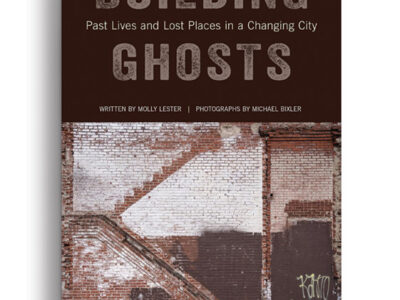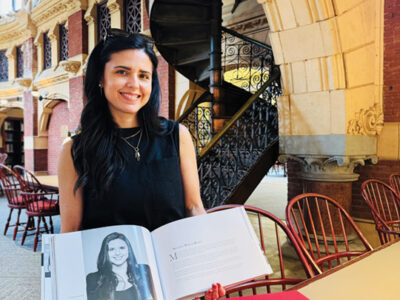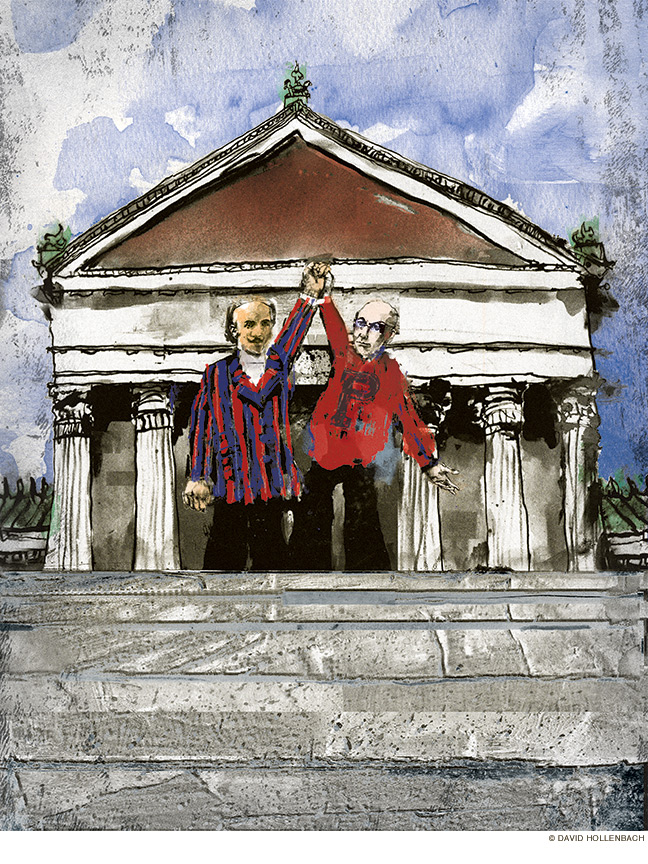
At the turn of the 20th century, Julian Abele and Louis Magaziner—a black man and an immigrant Jew—were standouts in Penn’s School of Fine Arts about to launch distinguished careers in architecture. They were also beginning what would be a lifelong friendship. A Magaziner descendant and Abele admirer investigates what brought them together.
By Amy Cohen | Illustration by David Hollenbach
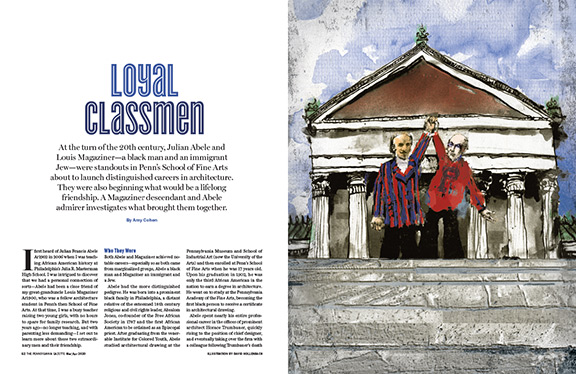
I first heard of Julian Francis Abele Ar1902 in 2006 when I was teaching African American history at Philadelphia’s Julia R. Masterman High School. I was intrigued to discover that we had a personal connection of sorts—Abele had been a close friend of my great-granduncle Louis Magaziner Ar1900, who was a fellow architecture student in Penn’s then School of Fine Arts. At that time, I was a busy teacher raising two young girls, with no hours to spare for family research. But two years ago—no longer teaching, and with parenting less demanding—I set out to learn more about these two extraordinary men and their friendship.
Who They Were
Both Abele and Magaziner achieved notable careers—especially so as both came from marginalized groups, Abele a black man and Magaziner an immigrant and a Jew.
Abele had the more distinguished pedigree. He was born into a prominent black family in Philadelphia, a distant relative of the esteemed 18th century religious and civil rights leader, Absalom Jones, co-founder of the Free African Society in 1787 and the first African American to be ordained as an Episcopal priest. After graduating from the venerable Institute for Colored Youth, Abele studied architectural drawing at the Pennsylvania Museum and School of Industrial Art (now the University of the Arts) and then enrolled at Penn’s School of Fine Arts when he was 17 years old. Upon his graduation in 1902, he was only the third African American in the nation to earn a degree in architecture. He went on to study at the Pennsylvania Academy of the Fine Arts, becoming the first black person to receive a certificate in architectural drawing.
Abele spent nearly his entire professional career in the offices of prominent architect Horace Trumbauer, quickly rising to the position of chief designer, and eventually taking over the firm with a colleague following Trumbauer’s death in 1938. Because Trumbauer’s employees did not sign their work, and because scant correspondence among Trumbauer’s employees remains, and because of the racial implications of denying Abele his due, there is much debate about how big Abele’s role was in various projects. The following carefully crafted generalizations, however, do reflect the consensus view of his career:
Abele contributed to many projects including a slew of Gilded Age mansions and the Philadelphia Museum of Art. He was instrumental in designing the Parkway Central Library (the Free Library of Philadelphia’s main branch) and Widener Library at Harvard. It is incontrovertibly true that Abele was the lead architect for the Duke University campus, encompassing 39 buildings, including dormitories, an indoor stadium, classroom buildings, and the Duke Chapel—though his role was generally ignored until Abele’s great grand niece Susan Cook brought it to the university’s attention in 1988.
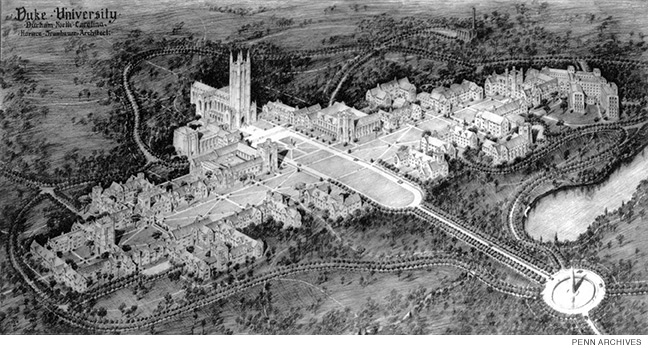
Magaziner was born in Humenné, Austria, now part of Slovakia, in 1878. At age 10, he immigrated to Philadelphia along with his parents and seven siblings to join three of his sisters who had come over earlier, finding success as dressmakers serving Philadelphia’s established German Jewish community. He graduated from Central High School and then went to Penn, completing a degree in architecture in 1900.
After graduation, Magaziner worked for and founded a variety of firms, most notably Magaziner, Eberhard, and Harris. He worked in a range of styles, ranging from North Broad Street’s Art Deco Uptown Theater, the now demolished Mt. Sinai Hospital in Pennsport, the modernist Sidney Hillman Medical Center on 20th and Chestnut (also demolished), and Amalgamated Clothing Workers building on 20th and South, as well as many other projects in Philadelphia and elsewhere.
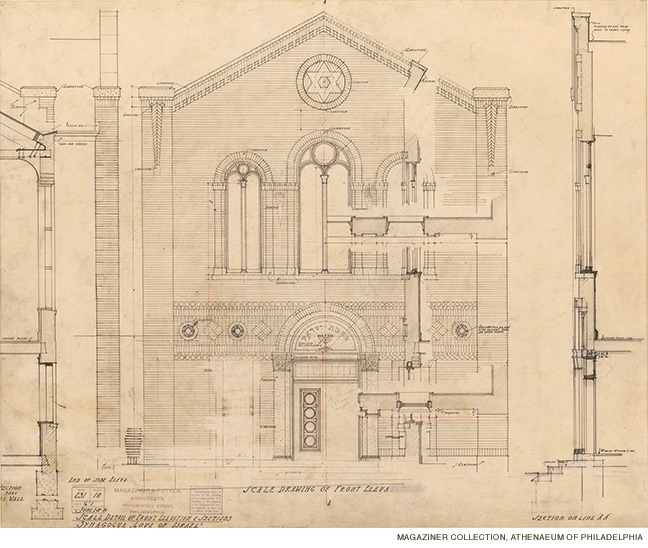
Oppressed Minorities Bound Together?
When I began my investigation into their relationship, my first stop, I admit at the risk of having my Penn master’s degree in history revoked, was Wikipedia. The entry for Abele, after noting that he was the first black student admitted to Penn’s architecture program, added: “On projects assigned to pairs of students, he partnered with Louis Magaziner, the only Jewish student in the department, who also faced discrimination. This was the beginning of a lifelong friendship between the two.”
I found a similar description on a remarkable family website organized by Magaziner descendant Tracey Rich: “At Penn, Louis was a classmate and friend of Julian Abele, the first black architect to graduate from that University. Louis was the only Jew in the program at the time, and their shared status as disparaged minorities in the predominantly wealthy WASP program was the beginning of a lifelong friendship.”
Was I ever excited! As a product of 13 years of Quaker schooling, a veteran of eight years teaching African American history, and a Jew to boot, this story of oppressed minorities bound together in defiance of the aristocracy got my self-righteous juices flowing.
Plus, as a former group leader and board member for Operation Understanding, a leadership program for African American and Jewish youth, I am quite familiar with the long and continuing history of the Black-Jewish alliance, dedicated to expanding rights and dignity to all Americans. I was pretty certain that the Abele-Magaziner friendship was one more example of this special relationship. As I pursued the story, however, the narrative kept shifting and my understanding of their friendship became more complicated.
One of the first sources I consulted was an unpublished manuscript written by Henry Magaziner Ar’36, Louis’s son. Henry followed in his father’s footsteps by going to Central and then Penn for architecture. He joined his father’s practice and later became a well-known architectural historian and the regional historical architect for Independence National Park.
Henry was very fond of Julian Abele and hoped to write a historical novel for young adults based on Abele’s life. I came across a manuscript at The Athenaeum of Philadelphia, a private library known for its architectural collection.
A passage from Henry’s never published draft:
During Lou’s last two years and Julian’s first two at Penn, the Jew and the African American joined forces. Both did beautiful work. They became buddies. Ate lunch together, attended the football games together, and developed a friendship which was to last throughout their lives.
Another passage from Henry’s manuscript describing a scene from a few decades later:
One Saturday, Julian and his friend Lou werenhaving their usual weekly lunch together. Lou said, “The other day I was inbyour Union League addition. It’s really very handsome.”
Julian replied, “Thanks. But you won’t believe it; I couldn’t even go in through the front door! Because I’m black, I had to use the servant’s entrance.”
“Well, I’m white,” said Lou, “so I did go in through the front door. However I’m Jewish so I can’t join the club. But making you use the servants’ entrance—and you were the architect, that’s unforgiveable.”
Naturally I ate up this fictional conversation, longing for it to be true. Indeed, thanks to Henry, my civil rights narrative remained intact. Here’s the thing about Henry, though: He was a very liberal Democrat. He was also a resident of progressive West Mount Airy and was married to a teacher at a Quaker school. Alas, Henry was just as susceptible as I am to the oppressed outsider narrative.
My next research trip brought me to the Architectural Archives at Penn. During the time Abele and Magaziner were students, the School of Architecture followed the École des Beaux-Arts system of instruction. In a 1926 description of the program written by a Penn professor, I found the following shocking paragraph.
“In an atelier one of the causes for the rapid development of the new student is the tradition already mentioned as one of the features of the Ecole system—the older, more advanced pupils helping the younger; and what goes with it, the younger men working for the older. This latter is called ‘niggering’ and consists of doing anything the advanced man asks …”
We know that Abele and Magaziner were indeed formally paired in this way and, most likely, this pairing was based on their outsider status. We can also make some assumptions about the WASP-supremacist atmosphere in which they prepared for their chosen profession. Besides Abele, the only other African American likely to have been in College Hall, where the program was housed, would have been the janitor. Magaziner would have been similarly, though less obviously, isolated from the mainstream of whatever social life and sense of camaraderie existed among his peers.
But as I spent time looking through old yearbooks, my narrative of oppression was challenged. Magaziner was given the honor of designing, and even signing, the yearbook cover for Penn’s Class of 1900. Abele, moreover, was a winner, a leader, the star student of the Class of 1902. The Beaux Arts system involves numerous competitions, and Abele garnered more first-place awards than any student in his class. As a junior, he won a competition to design the Pretty Memorial Alumni Award, a commemorative tablet that now hangs on the first floor of Van Pelt Library. That year his design was also selected for the Conklin Memorial Gateway that still graces Haverford College, and he won the Arthur Spayd Brooke Memorial prize awarded to the student showing the most promise. Most significantly, Abele was elected by his classmates to be the president of the Architectural Society. A photograph showing Abele sitting, almost kinglike, among his peers pretty much summed up his position in Penn’s architectural firmament.
So, I had to let go of my notion of Abele and Magaziner as outcasts linked by a shared sense of indignation at their oppression. There had to be another bond between them. I needed to dig deeper.
A Pair of Refined, Artistic Souls?
Another Athenaeum resource: a binder of transcribed interviews done by architectural historian and Abele biographer Dreck Spurlock Wilson in the late 1980s. Wilson spoke to relatives and others who had direct memories of Abele, and a consistent picture emerged. He was described as cultured, quiet, fastidious, and dapper. His hobbies included needlepoint, woodworking, painting, and playing the piano. He attended operas and symphonies. He wore a suit even when vacationing in Wildwood. The closest he ever came to using profanity were the words “confounded” and “darn.”
Try to envision his home at 1515 Christian Street in South Philadelphia as described by his great nephew John Cook: “The living room was 18th century French. He would do his own needlework for the sofa. The dining room was very elegant. He had one Fragonard painting that was huge. And on the other side he had another Fragonard painting. [Think French gentry lounging in rural landscapes.] He had the dining room table in the center of the room. Everything was right, even the fancy sterling silver. We had to dress for dinner.”
In reading these interviews, it is also clear that Abele was far from a racial firebrand. His wife, Marguerite, was white. He had black servants. In a 1986 Smithonian article on the belated recognition Abele was receiving for his work at Duke and other designs, Wilson was quoted as saying that, “For all intents and purposes, Julian did not consider himself black. He was almost a-racial. He buried himself in being an artist.” And in African American Architects: A Biographical Dictionary, 1865-1945, which Wilson edited, Abele’s entry asserts that he “considered himself an artiste beyond racial classification—neither Black nor White.”
So a new potential narrative emerged. My mom’s most vivid memories of her Uncle Lou are that he always took out his drawing materials when she would visit his Powelton Village home. She also recalls that after a leak ruined a patch of ornate wallpaper, Uncle Lou painted in the damaged area with his own hand.
My new theory: Magaziner and Abele were both refined, artistic souls. As such, I surmised, they must have respected each other’s sophistication and taste. As Abele deemphasized his blackness and spent most of his free time perfecting his home and engaging in artistic pursuits, I surmised that Magaziner, similarly, was too ethereal to be deeply engaged in the Jewish community.
I found some evidence to support my new theory during a visit to the Penn Archives—a note to Lou from Warren Powers Laird, then dean of the School of Fine Arts, indicating that he had enclosed a letter of introduction for Abele and Magaziner to use during their upcoming trip to Europe. Although the trip never took place, it made sense to me that these two sensitive lovers of high art would want to tour the continent together.
I also found the 1900 school of architecture yearbook, and Magaziner’s rather surprising senior projects: plans for an Episcopal Church and a Baptismal Font. I quickly concluded that Magaziner, like Abele, did not identify with his own people.
This theory lasted only as long as my next trip to the Athenaeum, however. Magaziner was a meticulous record keeper. Going through his files, it was clear that many of his clients and contractors were Jewish. He was the architect for the Penn State Hillel, a Hebrew orphan home, the Jewish National Farm School (now Delaware Valley University), and several other Jewish projects. His firm partners, Victor Eberhard and James Russell Harris, were both members of the WASP establishment, so I think we can assume that Magaziner was working with other Jews by choice rather than necessity.
Very late in his career, Magaziner had a series of exchanges about a proposed move of Mikveh Israel synagogue to Independence Mall. In one letter Henry Magaziner, who at that point was working closely with his dad, listed several synagogue projects by the firm. (By the way, while Mikveh Israel held off on moving at the time, they reconsidered a few years later and hired another Beaux Arts-trained Jewish graduate of Penn’s School of Architecture: Louis Kahn Ar’24 Hon’71.)
After I read Wilson’s interviews about Abele, he had become vivid to me, but Magaziner, although he was my relative, remained an abstraction several months into my research. I was frustrated and felt like I had hit a dead end. Then, I noticed that his obituary mentioned a few different organizations with which he was affiliated.
It turned out that the best way to get to know to my great-uncle was to visit the Jewish Archives at Temple University. It was there that I got to hear Lou’s voice, as I explored his central role in a variety of Jewish organizations.
Magaziner was a longtime member of the Pow Wow Club, a literary club launched in the 1890s by members of Philadelphia’s Jewish elite. According to Henry Magaziner, Lou sought inclusion in the group, something that was unusual for an immigrant lacking the status and deep roots of his German Jewish coreligionists. Lou spent decades as the secretary of the organization.
To my surprise, Uncle Lou was also a freemason. He was a member of the Hackenburg Lodge, which drew from a less elevated segment of Jewish society than the Pow Wow Club. Lou’s cohort in the lodge, where he served as treasurer, included an automotive parts distributor; a tire salesman; a purveyor of smoked fish; a hardware merchant; a scrap metal trader; a waste material dealer; a patrolman; and a wholesale hosiery jobber.
But the organization in which he seems to have been most active was the board of directors for the Hebrew Sheltering Home and Day Nursery. Located at School House Lane and Wissahickon Avenue in Germantown, this social service organization served the needs of Jewish orphans and unwed mothers. Lou’s involvement began in the early 1920s as the building’s architect. He served as chairman of the House and Grounds committee, a position that made use of his experience. And, touchingly, he also headed the welfare committee, charged with making sure the children and young women at the home received needed services and programming. From the 1920s into the early 1940s, Magaziner attended weekly Sunday meetings. Other family members also served in the organization, including my great grandfather Louis Herbach and his brother Joseph Herbach, who was the longtime president of the board.
So, clearly, when Julian Abele was home playing piano and doing needlework, surrounded by images of 18th century French aristocrats, Lou Magaziner was engaging in witty repartee with the Jewish elite, cementing his Americanness with the striving Jewish Masons, or getting into the weeds of running a large Jewish social service organization alongside members of his own extended family.
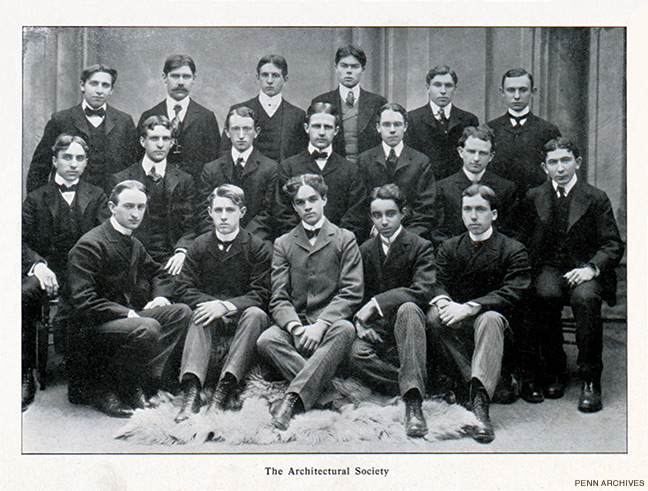
What They Shared
Clearly, Abele and Magaziner were not the civil rights activists I first pictured.
Nor were they both the sensitive artistic souls, more dedicated to aesthetics than the welfare of their own people.
And yet, they continued to meet for their Saturday lunches, surely one of the era’s few interracial pairs of friends. Often their post-lunch routine was to visit one or the other’s offices to offer critiques and encouragements, both finding that the input of their friend made their own work stronger. And it was to Magaziner that Abele turned for consolation when his wife Marguerite left him for one of her singing students. Henry Magaziner recalls hearing Abele literally cry on his father’s shoulder in their Powelton Village home as Abele grappled with the knowledge that his wife of nine years was in love with another man.
So here is what I think they shared.
First of all, they got to know each other during a period of youthful excitement and idealism. Don’t many of us retain affection for our high school or college friends long after our interests, priorities, or sensibilities have drifted apart? In spite of the many slights and barriers that made Abele’s life at Penn different than that of his white counterparts, he continued to speak fondly of Penn for the rest of his life. Magaziner, too, undoubtedly felt a few stings during his time at Penn, yet, like Abele, he clearly did well at and retained affection for his alma mater.
Secondly, they were both excellent architects. Abele designed more high prestige buildings, and Magaziner was able to demonstrate his skills in a wider variety of styles. But they both remained enamored of and respected within their chosen profession.
Third, they both displayed a particular type of pride. Both Abele and Magaziner were well-established architects who succeeded professionally very soon after graduating from Penn. But neither of them applied for membership in the American Institute of Architects (AIA) until they were nearing the end of their careers—not willing to openly challenge or risk rejection from what at the time was a notoriously racist and anti-Semitic organization. They both applied and were admitted in the 1940s, long after their respective bodies of work should have ensured their acceptance. We know from Henry Magaziner that Lou didn’t apply until he was personally invited to do so. Abele, with endorsements from the likes of Fiske Kimball, the longtime president of the Philadelphia Museum of Art, became the first black member of the Philadelphia chapter.
And I guess the final key must have been football. During the season, they skipped the Saturday office visits in favor of going together to watch the Quakers play. Apparently, they never missed a home game.
Amy Cohen G’01 is director of education at History Making Productions and a columnist for Hidden City Philadelphia.


